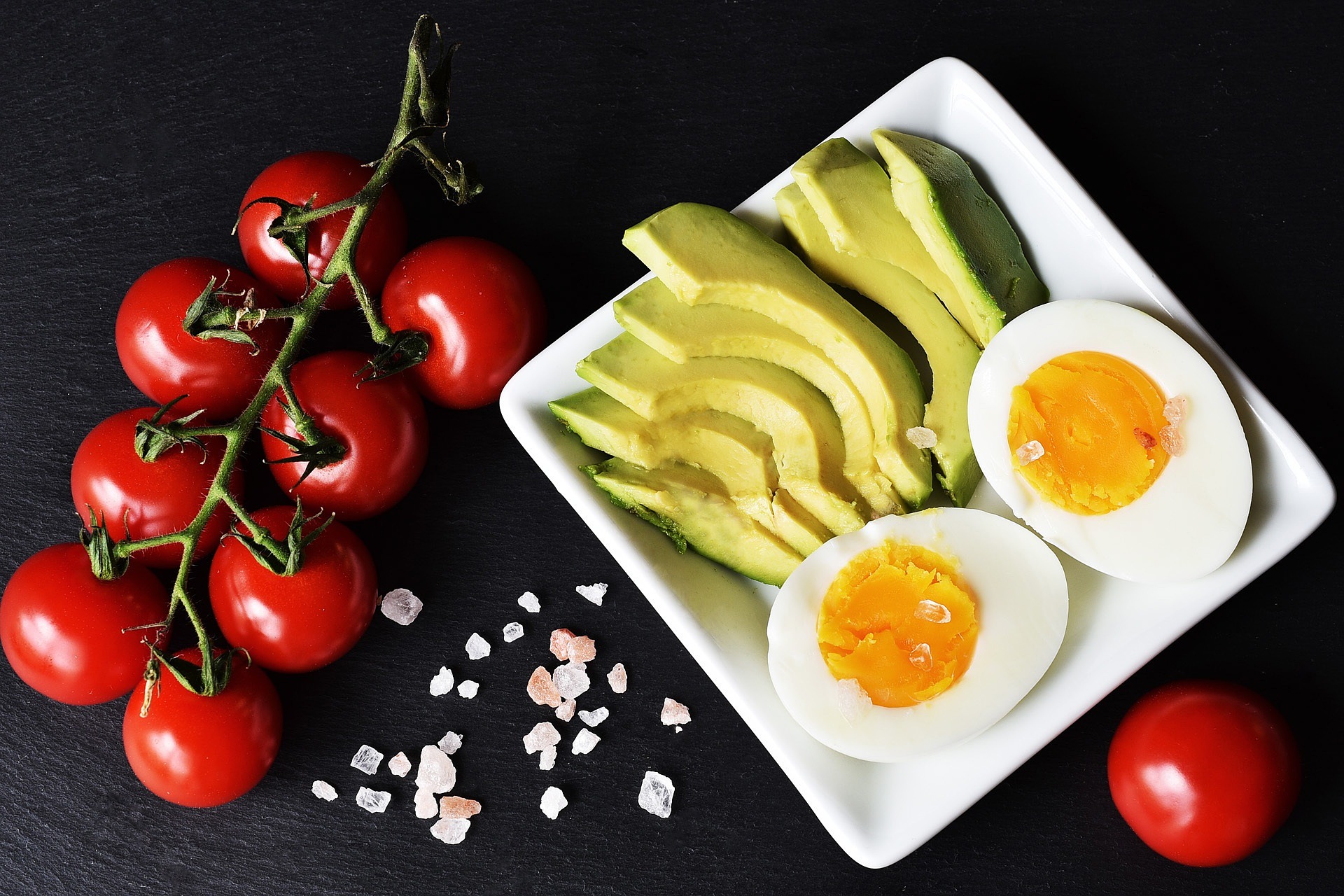3-Bullet Summary
You’ll benefit more from reading the article the whole way through. But, if you’re pressed for time, here’s a condensed version of The Best Study and Revision Techniques (and 5 You MUST Avoid):
- When it comes to study and revision techniques, there are so many out there that students end up getting confused.
- But, there’s a simple criteria students can use to assess whether the study and revision techniques they encounter are actually good: challenge, engagement and sustainability.
- Knowing this, there are clearly 5 common study and revision techniques that students should avoid (yet many still use): passive notetaking, rereading, highlighting/underlining, cramming and the Pomodoro Technique.
Feeling Lost?
It’s time to study for the exam. You sit at your cluttered desk, surrounded by a haphazard pile of textbooks, notes, and highlighters. Your laptop screen is open on a blank document, waiting for your keystrokes to transform it into a masterpiece of knowledge.
But, you don’t know how to study.
Overwhelmed with anxiety and the weight of procrastination, you decide it’s finally time to seek help. You open your browser. The search for online help begins. It’s a desperate plea for guidance, a lifeline thrown into the stormy sea of your academic struggles.
The search results pop up. You click on the first link — an article revealing how to study effectively
As you begin to read, however, a chill runs down your spine.
You’ve not been doing anything the article is telling you.
Self-doubt emerges. “Should I be highlighting and underlining?” you question. “Are study marathons the way to go?” you wonder.
Have you been studying wrong all along?
Introduction
Take a moment the next time you’re in an environment where people are studying or revising. Specifically, focus on how people are studying or revising.
I bet that 99% of people are taking and/or highlighting notes. (Excluding the students playing cards and smoking at the back of the room.)
Don’t get me wrong, taking notes is better than doing nothing. I got three A*’s at sixth form and I took notes like like a human photocopier without a stop button.
That was until I read Make It Stick.
In the book (which is one of The 7 Essential Books for Students Who Want Top Grades), the authors took aim at a whole bunch of study and revision techniques. They fired shots at loads of commonly used methods that simply don’t cut the mustard.
As I was reading the book, though, I felt exposed. Everything I’d been doing was wrong. Sure, I was doing well, but that was only because I was studying like a donkey for 8 hours per day.
It was from that point I decided to optimise my approach. I set out to investigate what else students like me were doing wrong, and shed light on how to study properly.
As of 2023, I’ve now worked with students for close to 3 years, entered my last year of university, and researched the science of learning vigorously. So, I can say with a degree of confidence that I now know what does and doesn’t work when it comes to studying.
In this article, we’re going to cover my discoveries. We’ll develop a framework for assessing how useful study or revision techniques are, and a clear idea of the those we must avoid like the plague if we want to study with maximum efficiency.
At the end of the day, studying is hard. So, why waste precious time and energy on stuff that makes it even harder?
Keep reading to level up your study and revision game for good.

The Best Study and Revision Techniques
When deciding which study and revision methods to use, there’s a simple criteria to follow:
- Challenging — Does this method force my brain to work hard?
- Engaging — Is this method (somewhat) enjoyable to do?
- Sustainable — Could I do this method every day for the rest of time, if I had to?
Let’s break down what these criteria mean in a bit more detail and go through some examples.
By challenging, we’re basically asking ourselves whether the method promotes active recall. This basically refers to the process of manually retrieving information from your brain and testing your brain’s ability to memorise.
Here are some good examples of active and challenging study and revision techniques:
- Flashcards
- Cornell notes
- Teaching from memory (AKA: the Feynman Technique)
- Making mind maps from memory
- Writing down as much as you can remember from memory (AKA: blurting)
- Answering past paper questions without notes
Now, we want to use active methods because studies have shown that they are the most important part of any study or revision strategy.
One paper from 1984, for instance, showed that active recall leads to better ability to learn and apply information1. 43 university students were given a 24-question exam based on a scientific paper about the brain. This exam assessed rote learning (i.e., memorising basic facts) and conceptual learning (i.e., being able to explain concepts in detail). Students were placed into one of two groups before sitting the exam:
- Control group — Subjects were told to study the paper using their default study methods (which were mainly passive, meaning easy). They also were told that they’d be sitting an exam and had to do as well as possible.
- Experimental group — Subjects were told they would be teaching what they learned from the paper to a student who would then sit the exam. However, they never actually got to teach the material, and had to sit the same exam as control group subjects.
Guess what?
Although rote learning scores didn’t significantly differ, conceptual learning scores were 80% higher in the experimental group! In other words, the active recall group that used teaching as a study technique performed better than the control group who used passive methods, especially when it came to showing high levels of understanding.
This study additionally found that experimental group subjects rated their enjoyment of and interest in the task far higher than the control group subjects. This neatly ties in with the second part of the criteria: engagement.
Some study and revision techniques are simply more enjoyable. I don’t know about you, but I’d much rather teach my notes to someone from memory than copy notes from a textbook. In the same vein, I’d much rather test myself on flashcards than spend an hour underlining my class notes.
This is a serious consideration.
Studying and revision are long-term games. You need to do them for many months to get good results. In turn, if you can find a method that you enjoy, which is probably an active one, then you’ll be more likely to stick with it. and reap the fruits of your labour.
Speaking of sticking with it, the final consideration for a study or revision method is sustainability.
By this, I mean that the study or revision method mustn’t be too crazy or complicated. The reason for this is, like with engagement, you need your studying and revision to be repeatable.
There are some techniques out there that loads of students use that are way too demanding. Students that use these methods often perceive studying and revising in a negative way. Then, they don’t want to do it because it takes such a toll on them. As a result, they get blitzed by the student who’s hungry to study and make progress every day, because this student has a sustainable approach — one that doesn’t force them to rely on willpower and motivation.
So, if you want to get the most out of studying and revision, you need your strategy to be easy to execute and not ridiculously extreme. The simpler and less demanding, the better.
The Worst Study and Revision Techniques
So, we now know the boxes we must check if we want to get the most out of our studying and revision techniques: challenge, engagement and sustainability.
Automatically, this means that we should avoid the opposite: ease, boredom and unsustainability.
In this section, however, instead of explaining these concepts, I’m going to give you some concrete examples. The following study and revision methods are ones that students continue to use but which fail to meet our criteria.
Aside from what to do, it’s equally important to know what not to do. By knowing what to avoid, you don’t have to waste time studying or revising ineffectively.
Warning: this list is probably going to hurt or offend you in some way.
These study and revision techniques are all really common, and you probably use one. However, instead of feeling ashamed or defensive, you should feel empowered. With this knowledge, you’ll be able to cut out the BS that isn’t maximising your efforts. In doing so, you can better leverage your time, allowing you to get more out of what you put in.
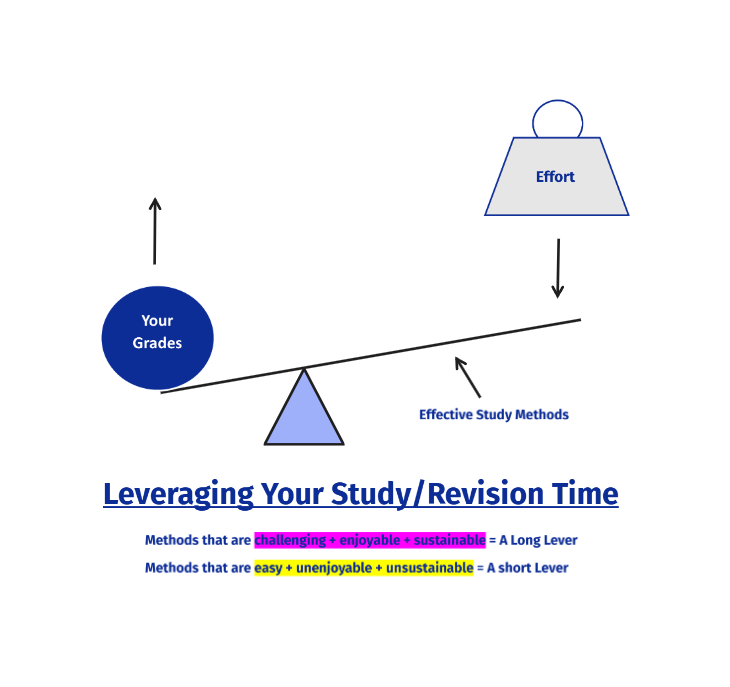
Want to work less hard for better results? Avoid these 5 study and revision techniques:
1) Passive Notetaking
96% of students take notes in classes and lectures and 88% of students believe that taking notes is necessary for good grades2.
To me, those statistics are crazy. We seem to really value notetaking. It’s like the default behaviour we’re socialised into as students.
Unfortunately, though, notetaking shouldn’t be our default — at least conventional notetaking.
Can you guess why?
Conventional notetaking, which involves rewriting what we hear or see, is a form of passive learning. This means that we don’t have to retrieve information from our brains to do it, and it’s not therefore challenging.
See, when you manually retrieve information from your brain, you force it to adapt and make you remember stuff, as the sheer effort required provides a signal for your brain to make the task easier (i.e., by making you smarter). Therefore, passive study methods that prioritise copying (which is easy) rather than recalling (which is hard) do not produce a strong enough signal to cause adaptation, and are less effective than active study methods.
In addition, passive methods just suck. Who wants to rewrite textbooks for 8 hours a day?
For these two reasons, passive notetaking needs to be put on the backburner. Yes, it’s easy, but easy isn’t necessarily good for your grades.
2) Rereading
Ah, rereading. A student classic.
What percentage of students would you estimate reread their notes as their primary form of revision?
I’ll wait.
…
The answer, according to a 2009 study, is 83.6%3. Yep, you heard me right: 83.6% of students default to rereading when studying exam material.
Why is this bad? Simple, rereading is another passive learning method. And, to make matters even worse, rereading is even more passive than notetaking!
Think about it, when you’re notetaking, at least you’re engaging with the material. You’re putting pen to paper (or finger to keyboard), and can phrase things in your own words (which is way better than copying word-for-word, btw). But, when you’re rereading, you’re quite literally doing nothing except, well, rereading.
Additionally, because we know that…
- A) in order to learn effectively, we must give our brain a signal to adapt, and
- B) the more effortful our studying is, the stronger the signal we give it to adapt,
… then the more passive a study method is, the worse it is at improving our memory.
As a result, rereading, which is the king of all passive methods, is arguably one of the least efficient ways to study.
So, if you want to save yourself a bunch of time (and willpower; rereading, like passive notetaking, is super boring), minimise the amount of rereading you do.
3) Highlighting and Underlining
This meme sums up highlighting (and underlining) pretty well:
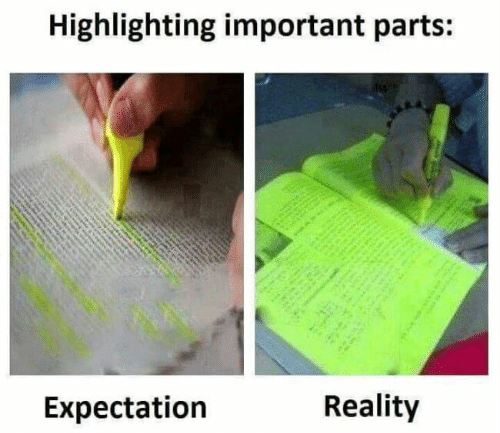
Credit: Snippet’s Blog (2021) Student’s guide to highlighting and note-taking. Available at: https://blog.gosnippet.com/students-guide-highlighting-note-taking/ (Accessed: 18 September 2023).
We set out with the intention to emphasise the most important bits from whatever we’re learning. However, what ends up happening is the creation of contemporary art.
This is one big reason highlighting and underlining suck. Students rarely know what they’re looking for in the first place, so end up having a field day rereading their notes and making them colourful.
This isn’t the main reason we shouldn’t be highlighting or underlining, though. This method should be removed from our arsenal because, like the previous two on the list, it’s incredibly passive. (Noticed the theme yet?)
See, when you highlight or underline, you’re not actively recalling information from your brain. Instead, you’re hoping the information will sink in by making it stand out.
Unfortunately, the brain doesn’t work like this. As we’ve learned already, we need to challenge our brains with effort if we want them to grow smarter. Due to the passive nature of highlighting and underlining, we don’t place our brains under any real stress. In turn, we don’t send it a strong adaptation signal — the signal we need to become more intelligent and remember information better.
In short, although it can be nice to make your work look pretty, this doesn’t lead to results. Don’t bother with highlighting or underlining.
4) Cramming
If you asked the average person to draw a student the night before an exam, they’d draw a caffeinated, sleep-deprived young adult trying to learn as much as possible.
Unfortunately, science shows that this exact image is actually pretty accurate.
One study found that approximately 45% of students ‘cram’ for their tests4, meaning they leave all the work until the last minute and then study/revise in overdrive mode. Further the BBC, in 2014, reported on a survey delivered to over 1,500 students, which found that 99% of students admit to having cram revised before exams. (The original study is dodgy, though, so take this statistic with a pinch of salt.)
Both figures are crazy. But, what’s even more crazy is the fact that spacing your studying and revision has been shown to be more effective than cramming for 90% of students5; we’re prioritising a method that has been shown to be worse than another!
There are several reasons why cramming is bad for your grades:
- It ignores the principle of spaced repetition — The best knowledge gains you make come from active recall over many months. In other words, you need to test yourself frequently to master a topic, as challenging repetition breeds mastery. Cramming is literally the opposite of this, hence why it is ineffective for so many students.
- Often, it comes at the expense of sleep — Studies have shown that <10% of students sleep for the recommended minimum 8 hours before final exams6, and cramming is a prime culprit. However, sleep is the closest thing to a performance-enhancing drug for students (i.e., it improves energy levels, focus, memory, etc.), so sacrificing it for a bad study method is a terrible trade.
- It’s needlessly stressful — I’m a firm believer that stress is good for us. But, when it can be avoided, it should, as there are always lots of stressors that crop up in our lives, but only so many we can actually recover from. So, instead of cramming 20 hours of brutal revision over a weekend and stressing ourselves to the point of burnout, why not just break those 20 hours down into bite-sized chunks to be completed over the course of a month?
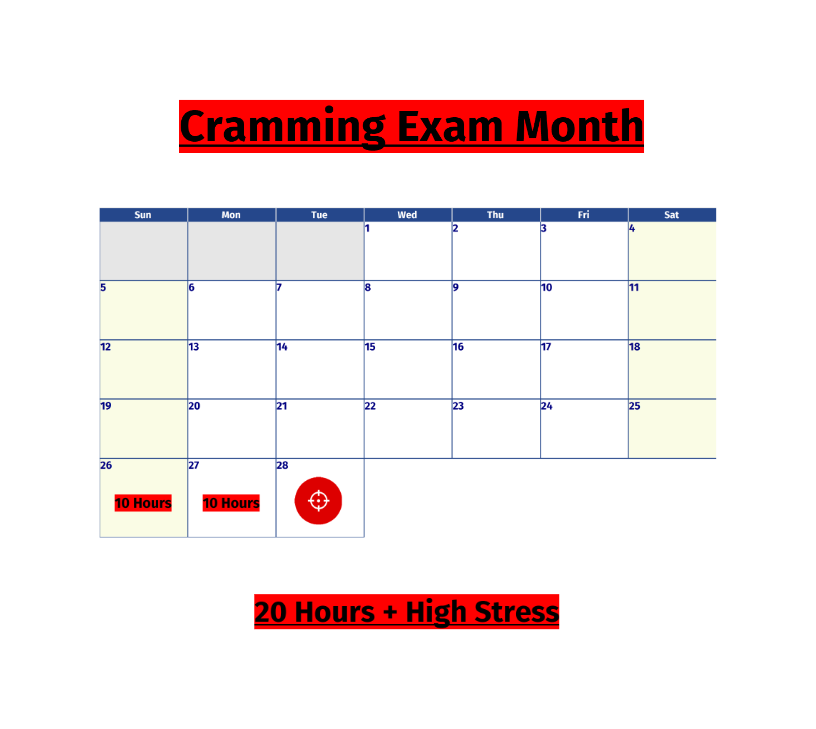
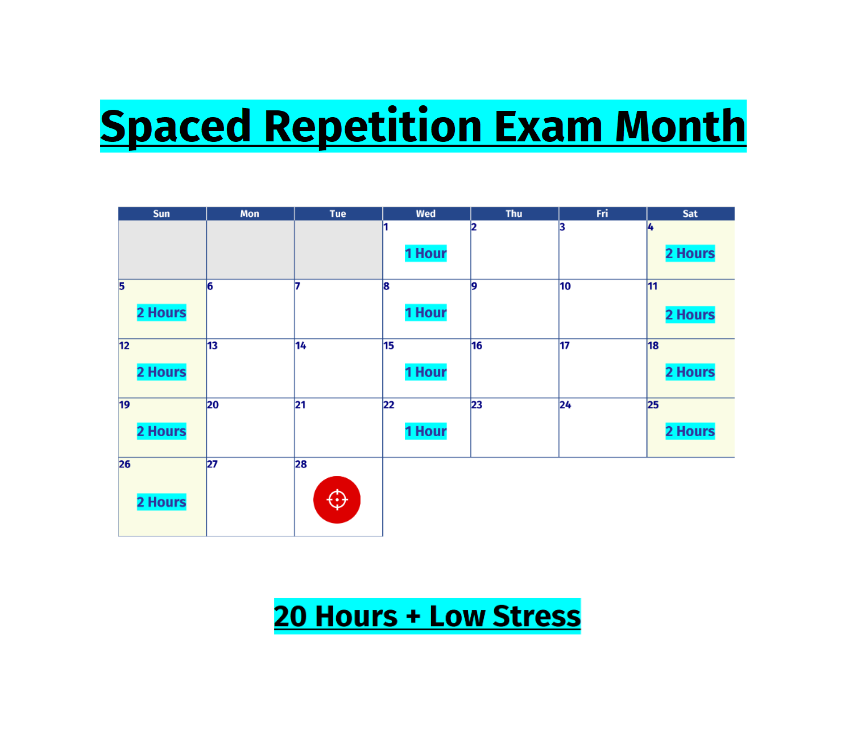
TL; DR: if you want to actually make the most of your studying and revision (and save future you a tonne of stress), space it out!
5) The Pomodoro Technique
The final study/revision technique I want you to avoid is the Pomodoro Technique.
This method, for those who haven’t heard of it, involves working for 4 short time blocks (usually lasting 25 minutes at a time) and intermitting them with shorter rest breaks (usually lasting 5 minutes at a time).
On paper, it sounds quite good. You work really hard for a little bit, rest, and then go again, giving your brain some rest in-between mentally taxing studying blocks.
However, in practice, this method has two severe limitations.
Firstly, it overlooks basic biology.
Humans are programmed to follow an ultradian rhythm. In simple terms, this means that throughout the day, we have natural peaks and troughs of energy and focus (e.g., the waves in the graph below). Our best work comes when our energy and focus peak, and worst when they trough (obviously).
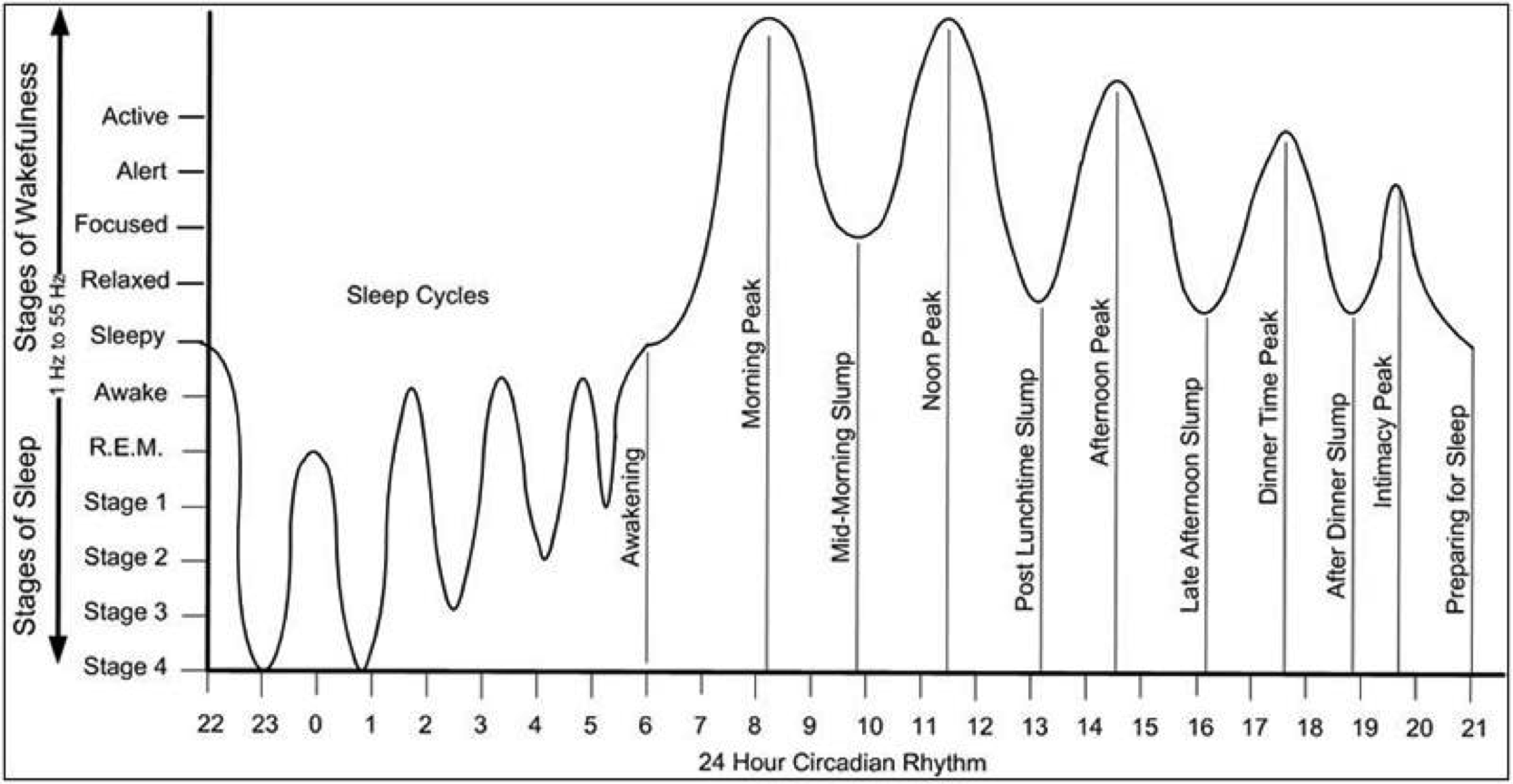
Credit: NuTesla (2016) Circadian rhythms, the true rhythm of life. Available at: http://circadian.nutesla.com/ (Accessed: 19 September 2023).
If we use the Pomodoro Technique, however, we basically ignore this.
For example, let’s say that we get a peak at 11:30am, meaning the 30 minutes either side of this time (11:00am–12:00pm) are our most productive. If we start our Pomodoro session at 11:00am, this means that we’re only going to milk 50 of these potential 60 minutes dry, and be resting for 10 minutes when we really don’t need to.
Now, you may be thinking, “Sam, surely 10 minutes lost isn’t that bad, right?” to which I’d respond, “For most people, yes.”
The reason for this ties in with the second big flaw of Pomodoro: it assumes that every minute during the 25-minute block is productive.
See, when we first start a task, it takes us time to really get ‘in the zone’ and focus. This is because it takes us up to 20 minutes to wear off the attention residue of the thing we were focusing on before7.
Think of it this way: if you’re on your phone for 5 minutes before a 25-minute Pomodoro block, when the time comes to study, you’re going to have the lingering thoughts from whatever you did on your phone (memes, posts you saw, etc.) for potentially 80% of the Pomodoro block, during which you will simple be less productive than if you’d just kept working. And, because you get so many rest breaks with Pomodoro, you’re constantly exposing yourself to attention residue by task switching so frequently!
Therefore, the Pomodoro Technique is counterintuitive to providing you with lots of super-focused minutes spent studying — the ones that actually drive progress!
It is because of these two huge drawbacks that the Pomodoro Technique, in my opinion, gets destroyed by long blocks of uninterrupted (deep) work. Yes, Pomodoro is better than nothing, but, if you want to be efficient and get in more effective minutes studying, drop it.
Final Thoughts: The Best Study and Revision Techniques (and 5 You MUST Avoid)
I’m all about maximising every minute a student dedicates to their education. Although some students will happily study for hours on end, others don’t have that intrinsic motivation. Regardless of which camp you’re in, you must admit that you don’t want to waste your time when you actually decide to study and revise.
But, because there are hundreds of study and revision techniques out there, it’s easy to get lost in a treacherous sea of hacks, time-management strategies and pseudo-science.
In this article, however, we’ve been through the methods that get a lot of clout, but are actually a waste of our precious time. Specifically, we’ve taken a deeper look into notetaking, rereading, highlighting/underlining, cramming and the Pomodoro Technique, and realised that they’re simply ineffective.
We’ve also armed ourselves with a criteria to judge study methods with, and learned a few examples of those that work.
You may be wondering now, though, about how to actually use the methods that do work in a study system?
Because I know how confusing it can be to study and revise the right way (and because I love you), I’ve put together two Ultimate Guides. If you want the truth behind effective studying, then check out The Ultimate Guide on How to Study Effectively. If you want to turn what you’ve studied into top grades, then head over to The Ultimate Guide on How to Revise for Top Grades.
These guides put what you’ve learned today into action, walking you through the exact steps you need to take to level up your study and revision strategy fast.
If, you’ve already read them both and you’re an absolute wizard, then be sure to claim your *free* copy of The 10 Secrets of Strong Students ebook. It’s literally the blueprint to becoming a straight-A student, and it costs you nothing.
Otherwise, keep working hard. You’re awesome and I’m proud of you.
Stay strong,
Sam.
Founder, Strong Students.






